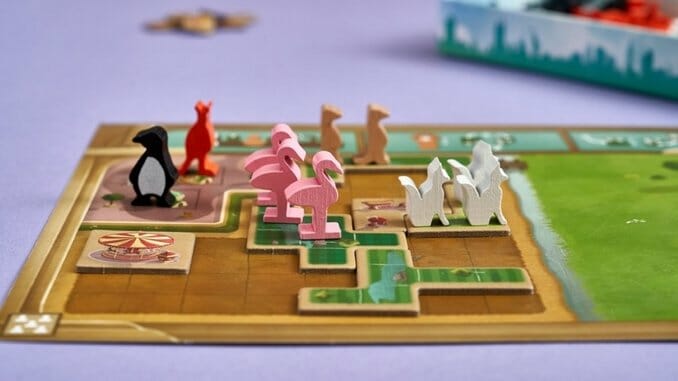Uwe Rosenberg’s Light Tile-Placement Game New York Zoo Is Absolutely Adorable
Images courtesy of Capstone Games Games Reviews board games
Uwe Rosenberg makes two kinds of games: heavy worker placement games, like Agricola, A Feast for Odin, and Le Havre, which can easily take two hours and reward deep knowledge of the games’ components; and lighter fare involving Tetris-like tiles, like the superb two-player game Patchwork and his series of games that started with Cottage Garden. I’m far more a fan of the latter style; while Agricola is great, he’s gone back to the same conceptual well too often for me, and those games have become more complicated without becoming more fun.
New York Zoo is one of his tile-placement games, and even within that set it’s on the lighter side, suitable for family play but with enough depth to satisfy more frequent gamers. The theme is a familiar one from plenty of other games—I’d call this a better reimagining of Zooloretto—where players must place animals in separate enclosures as they build out their personal zoos. Here, players must choose between taking tiles from the rondel and adding two animals to their zoo, with the goal of completing their entire boards with regular and bonus tiles before anyone else does.
The tiles are scattered around the central piece in stacks, randomly distributed but with the largest pieces on top of each stack. That central piece also has pairs of the game’s five animals—flamingos, penguins, arctic foxes, meerkats, and kangaroos—in fixed spots. On a turn, each player moves the elephant token a number of spaces of their choice (with the maximum depending on the player count) on to either one of those fixed spaces showing two animals or on to a stack of tiles. If the former, the player adds those two animals to their zoo, either directly on to enclosure tiles they’ve already placed or on to the temporary houses on their board, which serve as way stations if you don’t have room for that animal type. If they land on a space with the stack of tiles, the player takes the topmost tile and adds it anywhere to their board, so long as they have an animal in their houses to place on the new tile.

When the elephant crosses one of the five breeding spots on the board, which don’t count as a space for purposes of movement, every player gets to add one token of that animal type to up to two enclosures where they already have at least two of those animals. (I’ll leave it to you to work out exactly how that would transpire in a real zoo.) Once any enclosure tile is full, the player may then choose the largest remaining “attraction” or bonus tile, which run from eight squares, larger than any tile in the regular batch, down to just a singleton. You then remove all of the animals from that enclosure but one, moving that animal to one of your temporary houses if you have space. Thus there’s a light planning element to the game—ensuring that you are set up to take advantage of every breeding opportunity you can, while also considering what attraction tiles are still or might still be available when you get to choose—but it’s also well within the reach of younger players, with the game recommending it for ages 10+ and BoardGameGeek’s community rating at ages 8+.
New York Zoo plays up to five players, with different boards for each player count, and slight modifications to the rules for two and three players that allow you to gain a bonus animal at each breeding time. There’s also a very simple solitaire mode, where you have to try to fill your board before the elephant token completes two trips around the rondel—but you can only move it in a restricted fashion, using five movement tokens numbered 0 through 4. A solo game plays in about 15 minutes, a two-player game in about 30, and it’ll scale up from there.
My one quibble with New York Zoo is the colors of the various tiles, which come in four shades of green, each shade corresponding to a specific tile size. You’re supposed to sort the tiles by color (or size) during setup so that you can place the five-square tiles first, then the six-square tiles, then seven, then eight, but the colors are all so similar that it’s very difficult to tell them all apart without going off their actual sizes. It’s a minor complaint, though, in a fun and breezy game that I even prefer to Rosenberg’s highly regarded game Cottage Garden, which makes tile selection a bit more onerous. Here it’s far easier to move around and choose tiles, with the harder part deciding when to take a tile and when to take more animals. If you enjoy Rosenberg’s lighter fare, or games like Tiny Towns, Kingdomino, or Bärenpark, New York Zoo will probably be right up your alley.
Keith Law is the author of The Inside Game and Smart Baseball and a senior baseball writer for The Athletic. You can find his personal blog the dish, covering games, literature, and more, at meadowparty.com/blog.